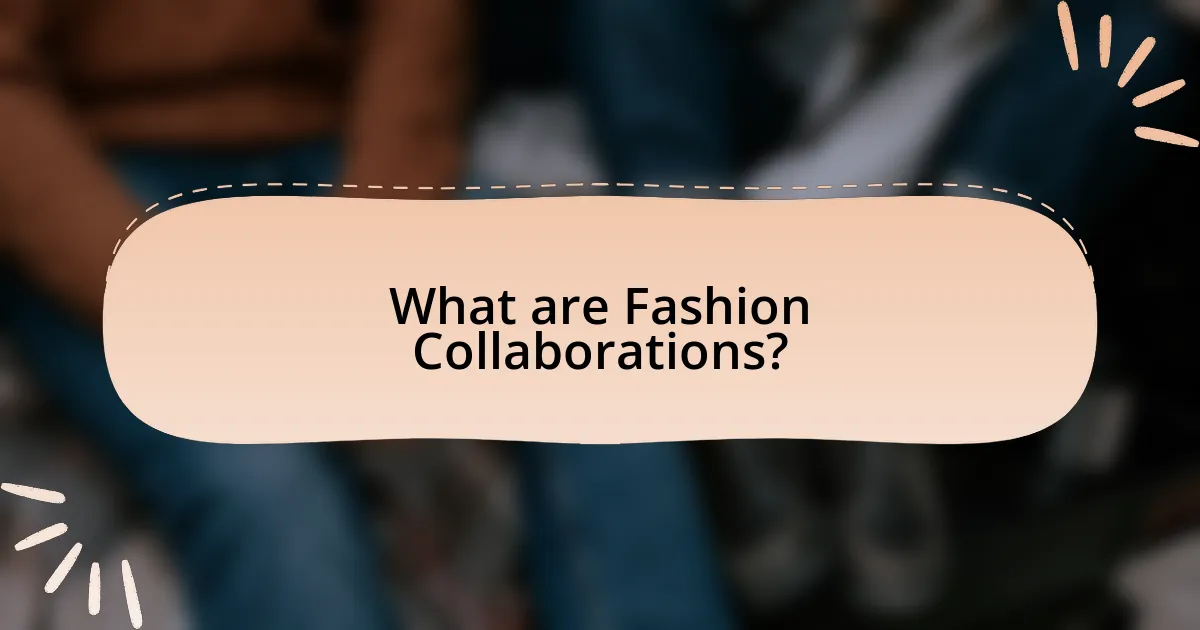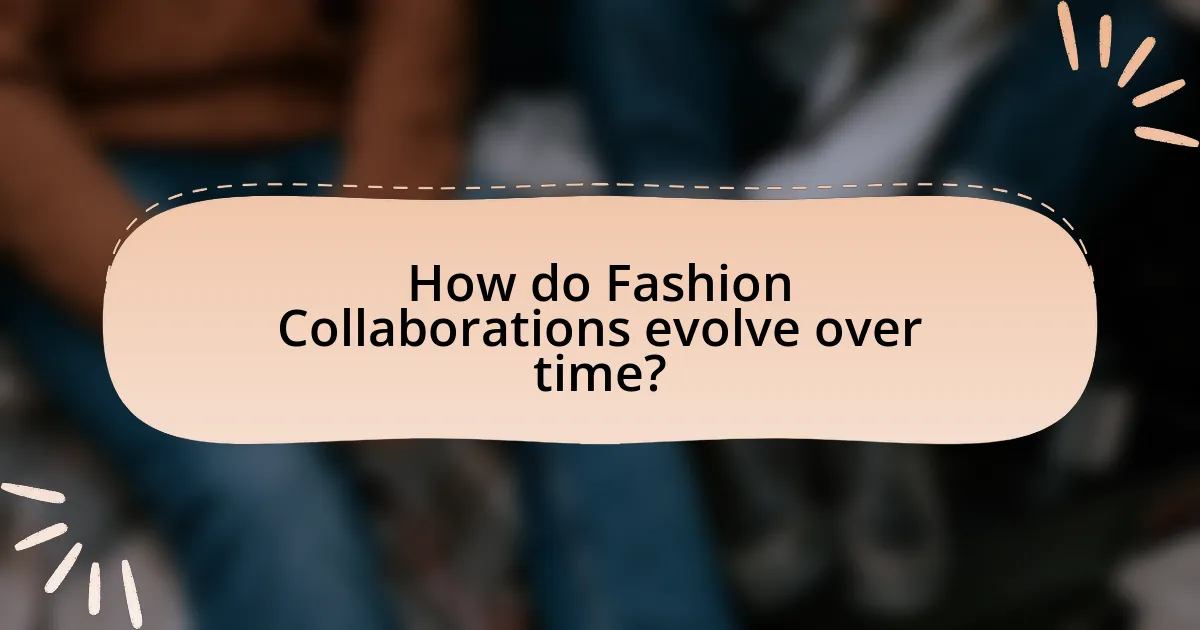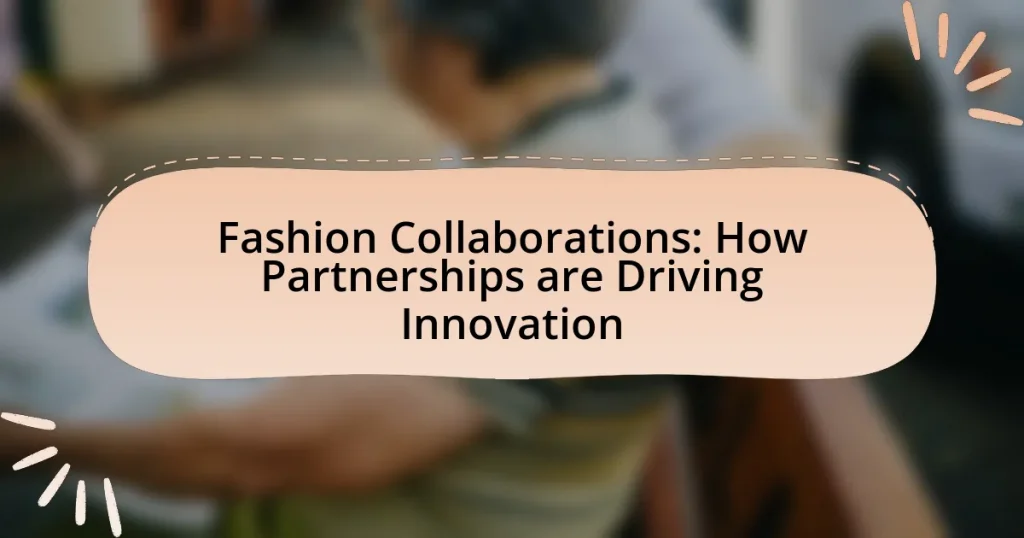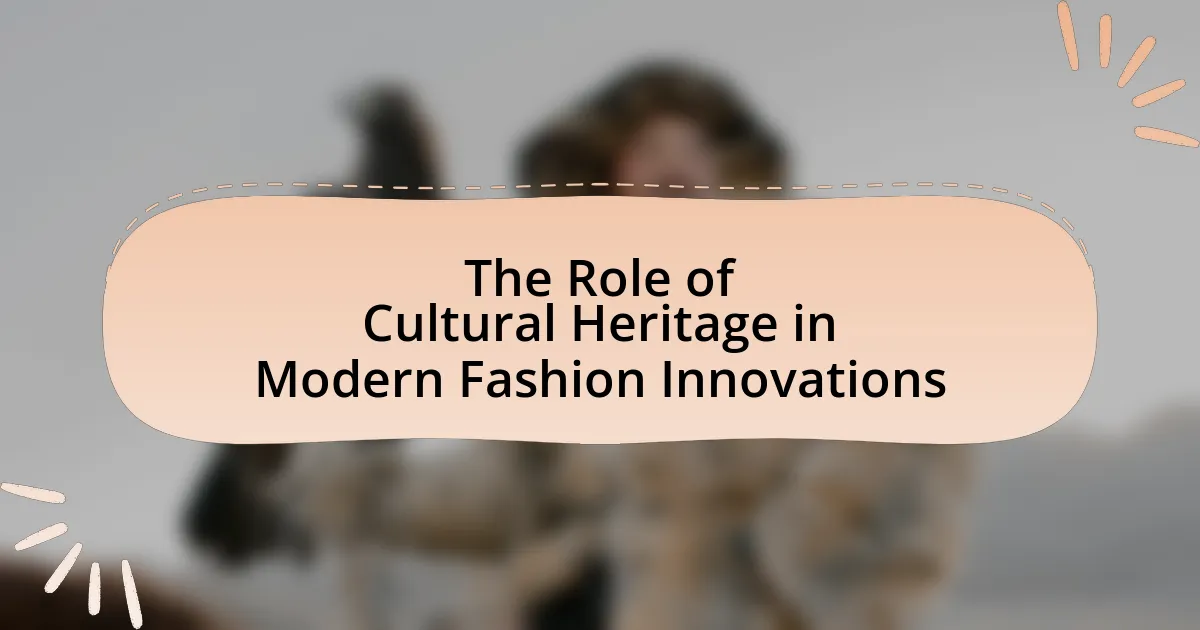Fashion collaborations are strategic partnerships between fashion brands, designers, or artists aimed at creating unique products or collections that blend distinct styles and expertise. These collaborations differ from traditional partnerships by focusing on creativity and limited-time offerings, often resulting in innovative designs that attract diverse consumer bases. The article explores various types of collaborations, their impact on brand visibility, and their role in driving innovation and creativity within the fashion industry. It also addresses the challenges brands face in these partnerships and outlines best practices for successful collaborations, emphasizing the importance of clear communication, aligned values, and understanding target audiences.

What are Fashion Collaborations?
Fashion collaborations are partnerships between fashion brands, designers, or artists to create unique products or collections. These collaborations often blend distinct styles and expertise, resulting in innovative designs that attract diverse consumer bases. For instance, the collaboration between Adidas and Kanye West led to the highly successful Yeezy line, which generated significant revenue and reshaped sneaker culture. Such partnerships leverage the strengths of each entity, enhancing brand visibility and driving market trends.
How do Fashion Collaborations differ from traditional partnerships?
Fashion collaborations differ from traditional partnerships primarily in their focus on creativity and limited-time offerings. Unlike traditional partnerships, which often emphasize long-term business strategies and stable brand alignments, fashion collaborations are typically characterized by unique, one-off projects that combine distinct styles and visions from different designers or brands. For instance, the collaboration between Adidas and Kanye West for the Yeezy line exemplifies how two entities can merge their creative identities to produce exclusive products that generate significant consumer interest and hype, contrasting with the more predictable outcomes of traditional partnerships.
What types of collaborations exist in the fashion industry?
In the fashion industry, several types of collaborations exist, including designer collaborations, brand partnerships, celebrity endorsements, and cross-industry collaborations. Designer collaborations involve established designers partnering with brands to create limited-edition collections, such as the collaboration between H&M and high-fashion designers like Karl Lagerfeld. Brand partnerships often occur between fashion brands and lifestyle brands to expand market reach, exemplified by Nike’s collaboration with Apple. Celebrity endorsements leverage the influence of public figures to promote fashion lines, as seen with Rihanna’s Fenty Beauty. Cross-industry collaborations merge fashion with other sectors, such as technology or art, illustrated by the partnership between fashion brands and tech companies for wearable technology. These collaborations drive innovation and expand consumer engagement within the fashion landscape.
How do collaborations enhance brand visibility?
Collaborations enhance brand visibility by leveraging the combined audiences and reputations of partnering brands. When two or more brands collaborate, they create a unique offering that attracts attention from both sets of consumers, effectively doubling the reach. For instance, a partnership between a high-end fashion label and a popular streetwear brand can introduce the luxury brand to a younger demographic that may not have previously engaged with it. This strategy is supported by data showing that collaborative collections often generate significant media coverage and social media buzz, leading to increased brand awareness. According to a study by the Fashion Institute of Technology, collaborations can boost brand visibility by up to 50% within targeted demographics, demonstrating their effectiveness in expanding market reach.
Why are Fashion Collaborations important for innovation?
Fashion collaborations are important for innovation because they combine diverse creative perspectives, leading to unique product offerings and fresh ideas. By merging the strengths of different brands or designers, collaborations can push the boundaries of traditional fashion, resulting in innovative designs that capture consumer interest. For instance, the partnership between Adidas and Kanye West for the Yeezy line revolutionized sneaker culture, blending high fashion with streetwear aesthetics, which significantly impacted market trends and consumer behavior. This synergy not only enhances creativity but also fosters a competitive edge in the rapidly evolving fashion industry.
What role do collaborations play in driving creativity?
Collaborations play a crucial role in driving creativity by combining diverse perspectives and expertise, which fosters innovative ideas. When individuals or organizations from different backgrounds collaborate, they bring unique skills and viewpoints that can lead to unexpected solutions and creative breakthroughs. For instance, a study published in the Journal of Business Research found that cross-disciplinary collaborations significantly enhance creative output by facilitating knowledge exchange and sparking new ideas. This synergy not only enriches the creative process but also leads to the development of novel products and concepts in the fashion industry, exemplifying how partnerships can catalyze innovation.
How do partnerships influence market trends?
Partnerships influence market trends by creating unique product offerings that attract consumer attention and drive sales. For instance, collaborations between high-end fashion brands and streetwear labels often result in limited-edition items that generate buzz and increase brand visibility. A notable example is the partnership between Louis Vuitton and Supreme, which not only combined luxury with street culture but also led to a significant increase in both brands’ market shares and consumer engagement. This phenomenon demonstrates how strategic alliances can reshape consumer preferences and establish new market dynamics.

What are the key benefits of Fashion Collaborations?
Fashion collaborations provide several key benefits, including increased brand visibility, access to new markets, and enhanced creativity. By partnering, brands can leverage each other’s audiences, resulting in a broader reach; for instance, the collaboration between Adidas and Kanye West significantly boosted Adidas’ market presence. Additionally, collaborations often lead to innovative designs that combine different aesthetics and expertise, as seen in the partnership between H&M and high-fashion designers, which has historically resulted in unique collections that attract diverse consumer interest. These collaborations also foster a sense of exclusivity and urgency, driving sales through limited-edition releases, exemplified by the success of the Supreme and Louis Vuitton collaboration, which generated substantial consumer demand and media attention.
How do collaborations foster innovation in design?
Collaborations foster innovation in design by combining diverse perspectives and expertise, which leads to the creation of unique and groundbreaking products. When designers from different backgrounds work together, they share ideas, techniques, and cultural influences that can inspire novel approaches and solutions. For instance, partnerships between fashion brands and technology companies have resulted in innovative wearable technology, such as smart fabrics that enhance functionality while maintaining aesthetic appeal. This blending of disciplines not only enhances creativity but also accelerates the design process, as seen in collaborations like Adidas and Parley for the Oceans, which produced sustainable footwear made from ocean plastic. Such partnerships exemplify how collaboration can drive innovation by merging resources and knowledge to address contemporary challenges in design.
What are some successful examples of innovative designs from collaborations?
Successful examples of innovative designs from collaborations include the partnership between Adidas and Kanye West, which resulted in the Yeezy sneaker line, known for its unique aesthetics and high demand, selling out within minutes upon release. Another notable collaboration is between H&M and designer Alexander Wang, which introduced a collection that combined high fashion with affordability, generating significant media buzz and consumer interest. Additionally, the collaboration between Gucci and The North Face produced a collection that merged luxury fashion with outdoor apparel, showcasing innovative designs that appealed to both brands’ audiences. These collaborations demonstrate how partnerships can lead to groundbreaking designs that resonate with consumers and drive market success.
How do collaborations lead to the development of new materials or technologies?
Collaborations lead to the development of new materials or technologies by combining diverse expertise and resources from different fields. This synergy fosters innovation, as seen in partnerships between fashion brands and technology companies, which have resulted in advancements like smart textiles and sustainable materials. For instance, the collaboration between Adidas and Parley for the Oceans has produced shoes made from recycled ocean plastic, demonstrating how joint efforts can address environmental challenges while creating new products. Such collaborations leverage unique insights and capabilities, accelerating the pace of innovation in material science and technology.
What impact do Fashion Collaborations have on consumer engagement?
Fashion collaborations significantly enhance consumer engagement by creating unique products that attract attention and foster brand loyalty. These partnerships often combine the strengths of different brands, resulting in innovative designs that resonate with diverse consumer bases. For instance, the collaboration between Adidas and Kanye West’s Yeezy brand generated substantial buzz, leading to increased social media interactions and heightened consumer interest. According to a study by the NPD Group, collaborations can boost sales by up to 30% due to the excitement and exclusivity they generate among consumers. This demonstrates that fashion collaborations not only drive innovation but also effectively engage consumers by tapping into their desire for unique and limited-edition products.
How do collaborations create unique customer experiences?
Collaborations create unique customer experiences by combining distinct brand identities and resources, resulting in innovative products that resonate with consumers. For instance, when high-fashion brands partner with streetwear labels, they merge luxury with accessibility, appealing to a broader audience. This fusion often leads to limited-edition items that generate excitement and exclusivity, enhancing customer engagement. A notable example is the collaboration between Adidas and Kanye West, which produced the Yeezy line, significantly impacting sneaker culture and driving sales. Such partnerships leverage the strengths of each brand, creating memorable experiences that differentiate them in a competitive market.
What strategies can brands use to maximize consumer interest in collaborations?
Brands can maximize consumer interest in collaborations by leveraging limited-edition releases, engaging storytelling, and influencer partnerships. Limited-edition releases create urgency and exclusivity, driving consumers to act quickly; for example, the collaboration between Adidas and Kanye West resulted in high demand and rapid sellouts. Engaging storytelling enhances emotional connections, as seen in the partnership between Nike and Off-White, which emphasized the narrative behind the designs. Additionally, influencer partnerships amplify reach and credibility, with brands like H&M successfully collaborating with high-profile figures to attract diverse consumer segments. These strategies collectively enhance visibility and desirability, leading to increased consumer interest in brand collaborations.

How do Fashion Collaborations evolve over time?
Fashion collaborations evolve over time through shifts in consumer preferences, technological advancements, and the merging of diverse cultural influences. Initially, collaborations often focused on limited-edition products that generated hype and exclusivity, as seen in partnerships like Nike and Off-White, which launched unique sneaker designs that appealed to both streetwear enthusiasts and high-fashion consumers. Over time, these collaborations have expanded to include more sustainable practices and inclusivity, reflecting a growing consumer demand for ethical fashion. For instance, the collaboration between Adidas and Parley for the Oceans introduced products made from recycled ocean plastic, showcasing a commitment to environmental responsibility. Additionally, the rise of social media has transformed how collaborations are marketed, allowing brands to engage directly with consumers and adapt quickly to trends. This evolution demonstrates that fashion collaborations are not static; they continuously adapt to societal changes and technological innovations, shaping the future of the industry.
What factors contribute to the success of long-term collaborations?
Successful long-term collaborations are primarily driven by trust, effective communication, and shared goals. Trust fosters a reliable partnership where parties feel secure in their commitments, leading to sustained collaboration. Effective communication ensures that all stakeholders are aligned, minimizing misunderstandings and enhancing cooperation. Shared goals create a unified vision, motivating all parties to work towards common objectives. Research indicates that organizations with high levels of trust and communication report a 50% increase in collaboration effectiveness, highlighting the importance of these factors in achieving long-term success.
How do changing consumer preferences affect collaboration strategies?
Changing consumer preferences significantly influence collaboration strategies in the fashion industry by prompting brands to align their partnerships with evolving market demands. As consumers increasingly prioritize sustainability, inclusivity, and personalization, brands are compelled to collaborate with partners that embody these values. For instance, a study by McKinsey & Company in 2021 highlighted that 67% of consumers consider sustainability when making purchasing decisions, leading brands to seek collaborations with eco-friendly designers or sustainable material suppliers. This shift not only enhances brand reputation but also drives innovation in product offerings, ensuring that collaborations resonate with the target audience’s values and preferences.
What lessons can be learned from past collaborations?
Past collaborations in the fashion industry reveal that effective communication and shared vision are crucial for success. For instance, the partnership between Adidas and Kanye West led to the Yeezy brand, demonstrating how aligning creative goals can result in innovative products that resonate with consumers. Additionally, collaborations often highlight the importance of leveraging each partner’s strengths; for example, the collaboration between H&M and high-end designers like Karl Lagerfeld showcased how merging luxury with accessibility can expand market reach and drive sales. These examples underscore that clear objectives and complementary skills are essential for fruitful collaborations in fashion.
What challenges do brands face in Fashion Collaborations?
Brands face several challenges in fashion collaborations, primarily including misalignment of brand values, differing target audiences, and logistical complexities. Misalignment of brand values can lead to a lack of authenticity, which may alienate consumers; for instance, if a luxury brand collaborates with a fast-fashion label, it risks diluting its image. Differing target audiences can create confusion in marketing strategies, as each brand may appeal to distinct demographics, complicating the collaboration’s messaging. Logistical complexities arise from coordinating production timelines, supply chains, and distribution channels, which can hinder the collaboration’s success if not managed effectively. These challenges necessitate careful planning and alignment to ensure that the partnership is beneficial for both brands involved.
How can brands navigate creative differences in partnerships?
Brands can navigate creative differences in partnerships by establishing clear communication and shared goals from the outset. This approach fosters an environment where each party can express their creative visions while aligning them with the partnership’s objectives. Research indicates that successful collaborations often involve regular check-ins and feedback loops, which help to address any discrepancies early on. For instance, a study by the Harvard Business Review highlights that companies that prioritize open dialogue and mutual respect in partnerships are more likely to achieve innovative outcomes. By implementing structured collaboration frameworks, brands can effectively manage creative differences and leverage diverse perspectives to enhance their collective innovation.
What are the risks associated with failed collaborations?
Failed collaborations in fashion partnerships can lead to significant financial losses, reputational damage, and missed market opportunities. Financially, brands may incur costs related to production, marketing, and distribution without achieving the anticipated returns, as evidenced by the 2019 collaboration between H&M and Moschino, which faced backlash and resulted in unsold inventory. Reputationally, a failed collaboration can tarnish a brand’s image, as seen when high-profile partnerships do not meet consumer expectations, leading to negative media coverage and consumer distrust. Additionally, missed market opportunities occur when brands fail to capitalize on trends or consumer demands due to ineffective collaborations, which can hinder innovation and growth in a rapidly evolving industry.
What are best practices for successful Fashion Collaborations?
Successful fashion collaborations require clear communication, aligned brand values, and a well-defined target audience. Clear communication ensures that all parties understand their roles, expectations, and creative visions, which minimizes misunderstandings and fosters a collaborative spirit. Aligning brand values is crucial, as partnerships that resonate with shared ethics and aesthetics tend to create more authentic and appealing products. Additionally, identifying and understanding the target audience allows collaborators to tailor their offerings effectively, enhancing market reception. Research indicates that collaborations between brands with complementary identities can lead to increased consumer engagement and sales, as seen in successful partnerships like Adidas and Kanye West’s Yeezy line, which generated significant revenue and brand loyalty.
How can brands effectively communicate their collaboration goals?
Brands can effectively communicate their collaboration goals by establishing clear messaging that outlines the purpose, benefits, and expected outcomes of the partnership. This clarity ensures that all stakeholders, including consumers and partners, understand the collaborative vision. For instance, successful brands often utilize targeted marketing campaigns, social media announcements, and press releases to articulate their collaboration objectives, which can enhance transparency and engagement. Research indicates that 70% of consumers are more likely to support brands that clearly communicate their values and goals, reinforcing the importance of effective communication in collaboration strategies.
What steps should brands take to ensure a successful partnership?
Brands should establish clear communication and shared goals to ensure a successful partnership. This involves defining roles, responsibilities, and expectations from the outset, which fosters transparency and alignment. Research indicates that partnerships with well-defined objectives are 30% more likely to achieve desired outcomes, as they minimize misunderstandings and enhance collaboration. Additionally, brands should regularly evaluate the partnership’s progress through feedback mechanisms, ensuring that both parties remain aligned and can adapt to any changes in the market or objectives.



